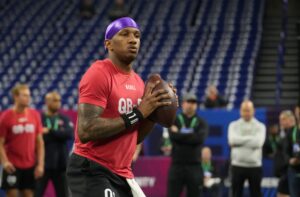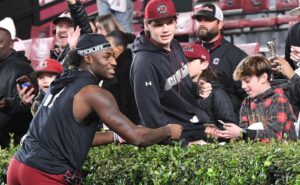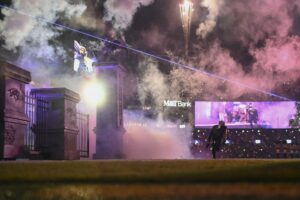Making our way to the NFC in our newest series breaking down team schemes, we begin with the Dallas Cowboys. The NFL’s biggest surprise last season were guided by the rookie backfield of quarterback Dak Prescott and running back Ezekiel Elliott and look to reclaim their top spot in the conference. Let’s take a look at the the Dallas Cowboys schematic philosophies employed on both sides of the ball in this version of “The Breakdown.”
The Breakdown: A Look at the Dallas Cowboys Schematic Philosophy
The Zone Running Game
With the help of an elite offensive line, the Cowboys have established the game’s most dominant zone running game that is predicated on efficiency. Due to the different intricacies between inside and outside zone, an offensive line has to be versatile to achieve optimal success withing such a scheme.
Outside zone runs are built on the offensive line moving in one direction as they work to pin defenders back or take the available leverage win to create a bend, bang or bounce window for the running back. This run cannot succeed, however, without a quality center who is tasked with working from snap-to-strike at a flat angle to cross the face of the defensive tackle, executing his reach block on the outside shoulder of the tackle.
Selecting a center in the first round of the NFL Draft, despite the recent trend, hasn’t developed into a commonality in the last 17 years. The Cowboys struck gold and it’s paying absolute dividends: a center getting displaced can spell disaster on any run or pass, but an outside zone run can’t even begin its development when a center is non-factor off the snap due to the clogged A-gap. That aforementioned versatility is found across the board and blends well with the groups’ athleticism to allow for successful double teams that these zone runs require. Releasing to the second level is all about timing and movement, and when the interior of the line has mastered such, it significantly widens running lanes and opens the potential for big gains.
Prescott undoubtedly stepped into the best possible scenario for a rookie quarterback with an offensive line of this magnitude and a budding star to hand the ball to, but the former Mississippi State passer was also tasked with making run checks and protection calls at the line and did so brilliantly. Rarely needing extra bodies to pass protect provides more targets to throw to (what a concept, right?), which further allowed the Cowboys to spread defenses out and attack with specific coverage beaters. Dallas’ receiving corp is rather diverse, so it wasn’t uncommon to feature both horizontal and vertical stretches of the defense on a single play.
Combining Prescott’s running ability with that of Elliott’s allowed offensive coordinator Scott Linehan to implement a variety of RPOs (run-pass options). What provided them with their uniqueness was Linehan’s ability to tie-in his base offense looks and designs, such as zone and counter runs, to put multiple defenders in a bind and force them to play with integrity. Forcing the defense to stay in more base looks to account for multiple outcomes naturally produces more explosive plays.
A Single-High System
Defensive coordinator Ron Marinelli employs a base 4-3 defense that features two-high shells such as Cover 2 and Tampa 2, but his desire to play Cover 3 is no secret. His Cover 3 looks to incorporate matchup principles along the perimeter that task corners with operating with man rules.
Although Marinelli will feature the occasional double-A-gap blitz, his system is reliant upon four-man rushes and simple coverage tactics as opposed to layered blitz concepts. His four down linemen were often manufactured pressure and sack opportunities via twists and stunts because of the group’s inability to win one-on-one matchups; it should come as no surprise that the Cowboys spent their first round pick on Michigan defensive end, Taco Charlton.
Only rushing four guys leaves the defense with seven to drop into coverage, which creates a numbers advantage within the back seven. Despite the fact that the offense will have a plus-one advantage in these base looks (five offensive linemen to block four pass rushers) there aren’t many quarterbacks who can successfully work late into downs, which is what this defensive advantage in the back end essentially compensates for. Thus, there is ample time for these defensive line tactics to get home.
The mixing of Cover 2 looks carries over into the bevy of Cover 3 usage and how Marinelli likes to disguise it – showing two-high pre-snap before rotating immediately after; this also opens the door for increased uses of Sky and Cloud roles. While most coordinators would opt to execute their blitz packages in similar scenarios to create ultimate confusion and movement, Marinelli is well aware of the risks behind doing so. The additions of cornerbacks Nolan Carroll, Jourdan Lewis and Chidobe Awuzie should come as no surprise to a team still in search of corners who can efficiently handle this system. A reliable, rangy centerfielder is also a necessity in any single-high system, which the Cowboys hope 2015 first round pick Byron Jones will become.
Elliott’s six-game suspension is difficult to manage, but it won’t decimate the offense altogether. Darren McFadden has proven he can effectively and efficiently succeed in this system, while Prescott already strikes most as a veteran. Expect the Cowboys to regress closer to the mean, but they remain the team to beat in the NFC East and one of the conference’s best.
Main Image:






